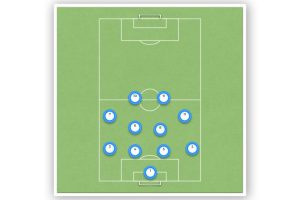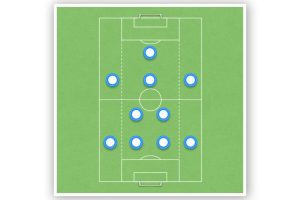The Key Principles of a Successful Counter-Attack in Soccer: A Comprehensive Guide
Counter-attack is a crucial aspect of soccer that can turn the tide of the game in favor of the team executing it. It involves quickly transitioning from defense to offense when the opposition loses possession of the ball. A successful counter-attack requires a combination of speed, accuracy, and teamwork.
There are several key principles that a team must follow to execute a successful counter-attack in soccer. Firstly, the team must be well-organized and disciplined in their defensive shape to quickly regain possession of the ball. Once possession is regained, the team must quickly move the ball forward with accurate passes to players in advanced positions. This requires good vision, awareness, and communication among the players.
Secondly, the team must have players with the right skillset to execute a counter-attack effectively. Players with pace, dribbling ability, and good decision-making skills are essential to break down the opposition’s defense. Lastly, dedication and commitment are needed from every player on the field during the counter-attack. Players must not stop pressing and moving forward, even if the initial attack breaks down.
Defensive Organization
One of the key principles of a successful counter-attack in soccer is defensive organization. This involves the ability to quickly transition from defense to attack when the ball is won back. There are two main sub-sections of defensive organization that are crucial for a successful counter-attack: positioning and marking.
Positioning
Positioning is the foundation of a good defense. The team must be able to maintain a good shape and remain compact, making it difficult for the opposition to penetrate. When defending, the team should aim to keep a good balance between pressure on the ball and cover for teammates. This means that players should be positioned in a way that allows them to quickly close down the ball carrier, while also being able to cover their teammates in case of a pass or a run.
A good way to maintain a good shape is to use a zonal marking system. This means that each player is responsible for defending a specific area of the field, rather than marking a specific player. This allows the team to maintain a good shape and makes it more difficult for the opposition to find gaps in the defense.
Marking
Marking is another important aspect of defensive organization. When defending, players should aim to stay close to their opponents, making it difficult for them to receive the ball or create space. This means that players should be aware of their opponents’ movements and position themselves accordingly.
There are several types of marking that can be used, depending on the situation:
| Marking Type | Description |
|---|---|
| Man-to-Man | Each player is responsible for marking a specific opponent. |
| Zonal | Each player is responsible for defending a specific area of the field. |
| Mixed | A combination of man-to-man and zonal marking. |
Regardless of the marking type used, it is important for players to communicate with each other and switch marking responsibilities when necessary. This allows the team to quickly adapt to the opposition’s movements and prevent them from creating scoring opportunities.
Transition
Transition is the most critical part of executing a counter-attack successfully. It is the moment when the team regains possession and quickly moves forward to create a scoring opportunity. During this phase, the players need to move as quickly as possible, and the ball needs to be passed with precision. There are two key principles that coaches need to focus on during the transition phase: speed and direction.
Speed
The speed of movement is crucial during a counter-attack. The team needs to move rapidly and with high intensity to catch the opposition off guard. Players need to sprint down the field and make quick, sharp movements to create space and opportunities. The faster the team moves, the more chance they have of creating a scoring opportunity.
It is essential to train players to move at high speed. Coaches can use drills that focus on speed and agility to help players become faster on the field. These drills can include ladder drills, cone drills, and sprinting exercises. By training players to move quickly, coaches can help them execute a successful counter-attack.
Direction
The direction of movement is just as important as speed during a counter-attack. Players need to move forward and attack the opposition’s goal as quickly as possible. The team needs to be organized and focused on moving in the same direction to create space and opportunities.
Coaches can use tactical drills to help players understand the importance of moving in the right direction. These drills can include passing exercises, small-sided games, and tactical simulations. By training players to move in the right direction, coaches can help them execute a successful counter-attack.
| Key Points | Explanation |
|---|---|
| Speed of Movement | Counter-attacking is a rapid, high-paced, high-intensity movement in the game that requires high-speed movements. |
| Passing Precision | During a counter-attack, players need to be able to pass accurately and quickly to create scoring opportunities. |
| Forward Movement | Players need to move forward and attack the opposition’s goal as quickly as possible. |
By focusing on the principles of speed and direction during the transition phase, coaches can help their team execute a successful counter-attack. Training players to move quickly and in the right direction can make all the difference in creating scoring opportunities and winning games.
Offensive Organization
When it comes to executing a successful counter-attack in soccer, offensive organization is key. This involves creating a system that allows for quick and efficient transitions from defense to offense, with players moving in a coordinated and purposeful manner. Two important sub-sections of offensive organization include spacing and movement.
Spacing
Proper spacing is crucial in a counter-attack, as it allows for quick and accurate passing and helps to create scoring opportunities. Players should be positioned in a way that allows for easy passing and movement, with forwards and midfielders pushing up the field and creating space for the attacking players to move into. The table below outlines some key points to keep in mind when it comes to spacing:
| Key Points |
|---|
| Forwards and midfielders should push up the field to create space for attackers |
| Players should be positioned to allow for quick and accurate passing |
| Spacing should be adjusted based on the situation (e.g. if the opposition is pressing high, players may need to drop back to create space) |
Movement
Movement is another crucial aspect of offensive organization in a counter-attack. Players need to be constantly moving and making runs to create space and opportunities for their teammates. This requires quick thinking and decision-making, as well as good communication between players. The table below outlines some key points to keep in mind when it comes to movement:
| Key Points |
|---|
| Players should be constantly moving and making runs to create space and opportunities |
| Good communication between players is crucial for effective movement |
| Movement should be purposeful and coordinated, with players working together to create scoring opportunities |
By focusing on proper spacing and movement, teams can create an offensive system that allows for quick and efficient counter-attacks. This requires good communication between players, as well as a solid understanding of the principles of counter-attacking soccer.
Execution
Executing a counter-attack in soccer requires precision, speed, and teamwork. The team must move quickly and efficiently to take advantage of the opponents’ disorganization when possession is lost. There are two key sub-sections to consider when executing a counter-attack: timing and decision-making.
Timing
Timing is crucial when executing a counter-attack. The team must be able to quickly transition from defense to offense when possession is regained. This requires players to be aware of their surroundings and anticipate when the ball will be won back. Additionally, players must be able to time their runs and passes to take advantage of the gaps in the opposing team’s defense.
One effective way to improve timing is to practice situational drills that simulate game-like scenarios. For example, a coach can set up a drill where the team starts in a defensive position and must quickly transition to an attacking position when possession is regained.
Decision Making
Decision-making is another critical component of executing a successful counter-attack. Players must be able to make quick, accurate decisions under pressure. This includes deciding when to pass, when to dribble, and when to shoot. It also involves knowing when to slow down the pace of the attack and when to speed it up.
One way to improve decision-making is to practice small-sided games that emphasize quick decision-making under pressure. Another effective method is to watch game footage and analyze the decision-making of successful counter-attacks.
| Timing | Decision Making |
|---|---|
| Quick transition from defense to offense | Quick, accurate decisions under pressure |
| Anticipate when possession will be regained | Decide when to pass, dribble, or shoot |
| Time runs and passes to take advantage of gaps in defense | Know when to slow down or speed up the attack |
Overall, executing a successful counter-attack in soccer requires a combination of timing and decision-making. Teams must practice situational drills and small-sided games to improve these skills and watch game footage to analyze successful counter-attacks. With precision, speed, and teamwork, a counter-attack can be a powerful weapon in a team’s arsenal.
Conclusion
Counter-attacking is a crucial aspect of soccer that can make or break a team’s success. By understanding the key principles of a successful counter-attack, coaches and players can improve their performance on the field.
The three key principles of a counter-attack are speed of movement, passing precision, and pattern play. Players must be able to move quickly and efficiently down the field, maintain accuracy in their passing, and follow set patterns to ensure success.
It is also important to note that timing is everything in a counter-attack. The best teams need about five to eight seconds to regain the ball and get a shot on target, so forward passing and running must be a priority to exploit this short time window.
Furthermore, successful counter-attacks require a team effort. Every player must be willing to get involved in the counter-attack and play their role to the best of their ability.
| Key Principles | Description |
|---|---|
| Speed of Movement | Rapid, high-paced, high-intensity movement requiring high-speed movements |
| Passing Precision | Accurate passing becomes even more important when players are moving at a rapid pace |
| Pattern Play | Team members run set patterns to ensure success and can be performed at a high tempo |
By implementing these key principles and working together effectively, teams can execute successful counter-attacks and gain an advantage over their opponents.








